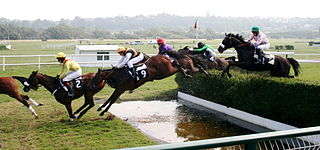 W
WA steeplechase is a distance horse race in which competitors are required to jump diverse fence and ditch obstacles. Steeplechasing is primarily conducted in Ireland, the United Kingdom, Canada, United States, Australia and France. The name is derived from early races in which orientation of the course was by reference to a church steeple, jumping fences and ditches and generally traversing the many intervening obstacles in the countryside.
 W
WThe Auteuil Hippodrome is a horse racing venue on Route des Lacs in the Bois de Boulogne, Paris, France. The 33-hectare (82-acre) race course opened November 1, 1873. It is designed exclusively for steeplechase racing.
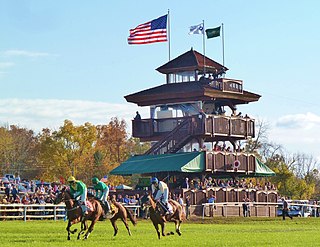 W
WThe Far Hills Races is a steeplechase horserace held annually in Far Hills, New Jersey, United States. The October 2018 event was the 98th running, and race day purses can equal up to or more than $1,000,000, with six races offering the highest purses on the National Steeplechase Association circuit.
 W
WThe Foxfield Races are a set of steeplechase races that originated in 1978 and are held twice annually in Albemarle County, Virginia, approximately eight miles northwest of downtown Charlottesville. It is a popular tradition for much of the community as well as students of the University of Virginia and other universities on the East Coast. Foxfield holds two races each year, one in the fall and another in the spring. The fall race has a more family-friendly atmosphere, while the spring race tends to attract a larger proportion of local college students. Each race generally benefits a local organization or charity; previous groups include Service Dogs of Virginia, the Ronald McDonald House, and Kids Pan Alley. There are many different color passes that can be purchased allowing access to certain areas in and around the track itself. Tickets can be purchased from the official website or from numerous outlets around the Charlottesville area, as well as surrounding areas. Traditionally, students and other attendees dress in a Southern, aristocratic style often seen at other steeplechase and horse racing events across the South. Seersucker, bowties, and pastel colors predominate the atmosphere, particularly at the spring race.
 W
WThe Grand Steeple-Chase des Flandres is a horserace held annually at the Hippodrome Waregem in Waregem, Belgium. It is the centrepiece of the Waregem Koerse meeting, held on the Tuesday of the Waregem Koerse Feesten, a kermesse which begins on the weekend of the last Sunday in August. Local businesses often close for the kermesse. The race is sometimes described as the Belgian Grand National, by analogy with the (English) Grand National. It has a distance of 4600m, with 25 obstacles, the most spectacular of which is the water jump across the Gaverbeek river, which is in front of the grandstand and taken twice in the race. In 1990 the water jumpwas redesigned to reduce the frequency of horses breaking legs; it faced continued criticism from animal welfare activists after deaths there in 2012. The Waregem Koerse was first held in 1849 on the city's cobbled streets; the Steeple-Chase was first held in 1858, sponsored by French businessman Marc Lejeune. In its early decades it was one of the most prestigious horseraces in Europe. It declined after the Second World War when French prize money grew, but recovered somewhat from the 1980s. In the 1990s there was an increase in the number of British entries, from smaller stables. Multiple winners include Spectre, Redpath and Taupin Rochelais. Since 2010 the race has formed part of the Crystal Cup series of European steeplechases.
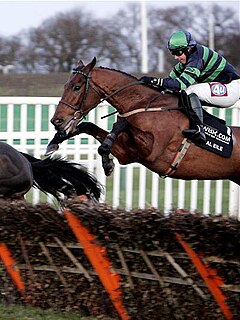 W
WA hurdle race in Great Britain and Ireland is a National Hunt horse race where the horses jump over obstacles called hurdles or flights that are over three and a half feet high. They are typically made of a series of panels made of brush and are flexible. Hurdle races always have a minimum of eight hurdles and a minimum distance of two miles (3 km).
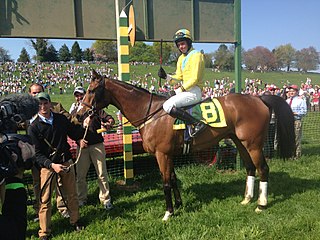 W
WThe Maryland Hunt Cup is a Timber race, which is an American Steeplechase. It was first run on May 26 1894 and won by Johnny Miller. Eight horses have won the race three times but no horse has won it four times. It is considered one of the most difficult steeplechase races in the world. Fred Winter, a famous English horse trainer who attended Jay Trump's 1966 race, was asked about bringing a horse over for the Maryland Hunt Cup, he responded "Why I wouldn't dare!" Two undefeated winners, Jay Trump and Ben Nevis II, went on to win the Grand National in England. Both horses are in the Hall of Fame.
 W
WMeadow Brook Steeplechase Association was a racing group on Long Island created on May 1, 1897. In 1914 their race was held on the property of Harry Payne Whitney.
 W
WThe Nakayama Daishogai (中山大障害) is a Grade 1 steeplechase horse race in Japan open to thoroughbreds which are three-years-old or above. It is run over a distance of 4100m at Nakayama Racecourse every year in late December. The 2020 edition has a prize money of 142,660,000 yen.
 W
WA point-to-point is a form of horse racing over fences for hunting horses and amateur riders. In Ireland, where the sport is open to licensed professional trainers, many of the horses will appear in these races before they compete in National Hunt races. Consequently, the Irish point-to-point is more used as a nursery for future young stars: a horse that wins its debut point-to-point in Ireland will often sell for a high price. Whilst professional trainers are specifically excluded from running horses in point-to-points in Great Britain, the days of the farmer running his hunter at the local point-to-point have gone. Increasingly, horses are run from "livery yards" - unlicensed but otherwise professional training establishments, sometimes closely allied with a licensed yard.
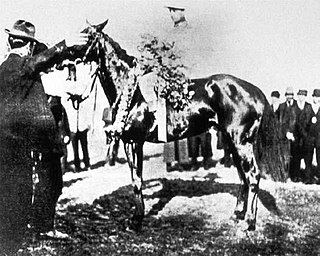 W
WVincent Minford Powers was an American Champion jockey and trainer who competed in both flat racing and steeplechase racing. He rode the winning horse Wintergreen in the 1909 Kentucky Derby and in 1927 and 1928 rode Jolly Roger to back-to-back wins in the most important steeplechase race in the United States, the American Grand National. He was inducted into the National Museum of Racing and Hall of Fame in 2015 as well as the Chautauqua County, New York Sports Hall of Fame in formal ceremonies held on February 16, 2015.
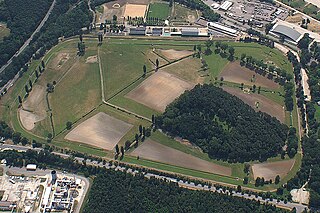 W
WVelká pardubická is a famous cross-country steeplechase run in Pardubice, Czech Republic since 1874. It takes place every year on the second Sunday in October.